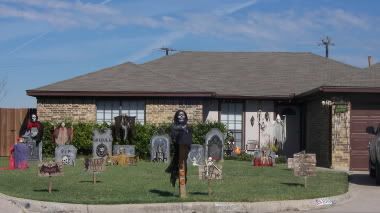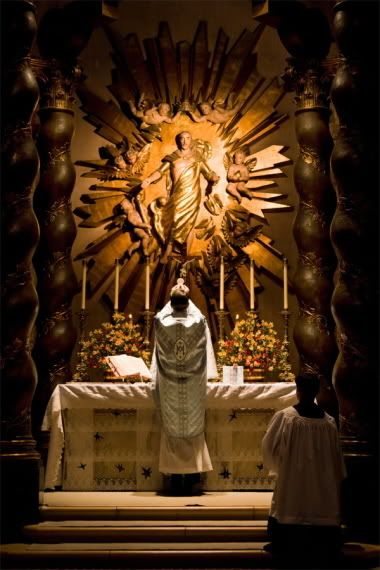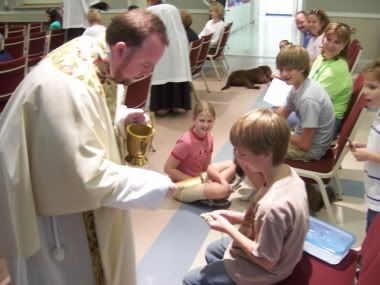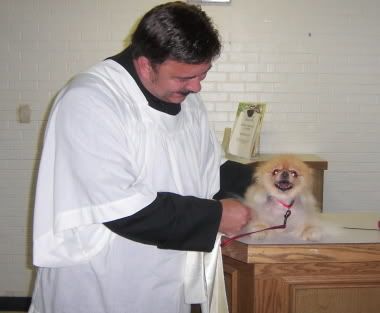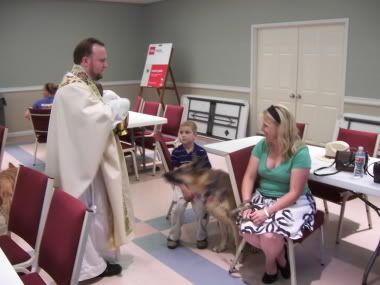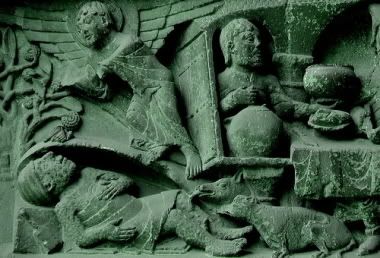 Click here
Click here to listen online. Given at St Alban's on Sept 30th.
If you were instantly killed in a car crash on the drive home today . . . And if, indeed as the Prayer Book says, “to thy faithful people, O Lord, life is changed, not ended,” then how will your life be changed? What will you see? What will you hear? What emotions will you feel? What will you be doing? What would give you comfort, fear, or joy?
Some of us have given thought to these questions before. Ancient merchants used to write the words
memento mori in their accounting books—it means “think of death.” Some of us have been afraid to even consider that question. Some of us are like the French King Louis XVI, who decreed that the word “death” never be uttered in his presence.
Jesus bids us to consider the subject today, in telling the parable about two dead men—Lazarus and Dives (the real name of the rich man is not given, but comes from the Latin Vulgate), whose lives are changed by the grave and gate of death.
The parable is a drama that unfolds in three acts. The first act describes the lives of two men who represents economic extremes. From the context, it seems that Dives is likely a Sadducee (and they were aristocrats who did not believe in an afterlife) He lives in luxury. All his needs are met, and so much more. Jesus put it,
“Blessed are you poor, for yours is the kingdom of God . . . Woe to you that are rich, for you have received your consolation.”The other man in the story is a poor beggar, appropriately named Lazarus, for the name means “one whom God has helped.” This is the only parable that uses a proper name, which may mean that it is a real story about real people, perhaps two recently departed people whom those in Jesus’ audience might have known personally. In any case, Lazarus is one who sits at the gate of the rich man’s home and begs for food from his overflowing table. He longs for scraps from the table, as he sits waiting for the trash to be put out, and yet he can’t even muster the strength to keep the dogs away. What a contrast of affluence and misery!
Dives is probably not a cruel man, but he is too absorbed in himself to see poor Lazarus, sitting at the door, longing for even a scrap from the table. Wealth is not necessarily wicked, but it has temptations that are hard for most people to resist. On the other hand, poverty is not necessarily a virtue, but it may bring forth faith by highlighting our common dependence upon the mercy of God.
One day, Act II arrives—both of these men die, and their experience of life is changed. This parable highlights the contrast between their lives before and after death. In earthly life, Dives enjoyed comfort and Lazarus was a poor beggar. After death, Lazarus enjoys the comfort of Abraham’s bosom and Dives is the beggar who longs for even a drop of water. Jesus tells us that at death, Dives descended to
Hades and Lazarus was carried by angels to
Abraham’s bosom. What are these places of which Jesus speaks?
In the Old Testament, the abode of the dead was called
Sheol in Hebrew. It was seen as kind of dark and sleep a place of rest for the departed. In the Greek Septuagint translation of the Old Testament and in the New Testament, the Greek word
Hades is used to translate
Sheol. In English, it is sometimes rendered as “hell,” but “abode of the dead” would be more accurate. Everyone went to
Sheol or
Hades.
As time went on and revelation progressed, the understanding came along that the afterlife was better for the righteous than the wicked. At the last day,
Sheol/Hades would bring forth its dead for resurrection and judgment and eternal life.
St Hippolytus of Rome, writing at the turn of the second century, described it:
“Now we must speak of Hades, in which the souls both of the righteous and the unrighteous are detained. Hades is a place in the created system, rude, a locality beneath the earth, in which the light of the world does not shine. And since the sun does not shine in this place, there is necessarily perpetual darkness there. This place has been destined to be, as it were, a guardhouse for souls. The angels are stationed there as guards distributing temporary punishments for characters, according to each one’s deeds. And in this locality there is a certain place set apart by itself, a lake of unquenchable fire, into which we suppose no one has ever yet been cast. . . . But the righteous (who will obtain the incorruptible and unfading kingdom) are indeed presently detained in Hades, but not in the same place with the unrighteous. For to this locality there is one descent, at the gate of which we believe an archangel is stationed with an army. When those who are conducted by the angels who are appointed unto the souls have passed through this gate, they do not all proceed down one and the same path. Rather, the righteous are conducted in the light toward the right. And being hymned by the angels stationed at the place, they are brought to a locality full of light. And there all the righteous persons from the beginning dwell. They are not ruled by any necessity. Rather, they perpetually enjoy the contemplation of the blessings that are in their view. Also, they delight themselves with the expectation of other blessings, ever new. In fact, they consider the new blessings as ever better than the first ones. And that place brings no labors for them. In that locale, there are neither fierce heat, cold, nor thorns. But the faces of the fathers and the righteous are seen to be always smiling, as they wait for the rest and eternal revival in heaven that follow this location. And we call this place by the name of 'Abraham's bosom.'However, the unrighteous are dragged toward the left by angels who are ministers of punishment. These souls no longer go of their own accord. Rather, they are dragged as prisoners by force. And the angels appointed over them hurry them along, reproaching them and threatening them with an eye of terror, forcing them down into the lower parts. And when the souls are brought there, those appointed to that task drag them on to the vicinity of Gehenna. And those who are so near (to Gehenna) hear incessantly its agitation, and they feel the hot smoke. And when that vision is so near, as they see the terrible and excessively glowing spectacle of the fire, they shudder in horror at the expectation of the future judgment, already feeling the power of their punishment. And again, when they see the place of the fathers and the righteous, they also suffer punishment merely from seeing this. For a deep and vast abyss is set there in the midst, so that neither can any of the righteous in sympathy think to cross it, nor do any of the unrighteous dare to cross it. I think I have said enough on the subject of Hades,” Hippolytus wrote,
“in which all souls are detained until the time that God has determined. And then He will accomplish a resurrection of all—not by transferring souls into other bodies—but by raising the bodies themselves.”At the moment of death, Dives is surprised to open his eyes to a new world. It was probably much different than anything he might had expected to see. He does not see family and friends, nor the saints and patriarchs of old. Instead, he finds himself alone, standing in a burning garbage pit outside the city. He cries out in pain and misery, unable to free himself. He is in dire thirst—both for water and for some relief. Lazarus takes notice of this beggar at the city gate and has compassion on Dives, but cannot do anything for him.
Thus begins Act III in our tale from Jesus’ lips. Dives’ pain of fire and thirst cannot compare with his pain of regret. He is overwhelmed with regret. He cannot save himself. But perhaps he can return to warn others about his fate. But his hopes are flawed. First, the Bible tells us that no one returns from Sheol. Second, even if someone could come to admonish the living, it would do no good for those who are not listening anyway.
Dives himself had not heeded the admonishment of the Law and Prophets, what difference would one more voice of warning make? Even a visitor from Sheol cannot change a selfish will. After all, King Saul was confronted by the ghost of the dead Prophet Samuel, and it did not change him for the better or help him return to God. Likewise, King Herod did not change his evil ways even when he thought Jesus was John the Baptist returned from the dead.
As Jesus put it,
“Blessed are you poor, for yours is the kingdom of God . . . Woe to you that are rich, for you have received your consolation.” This life is the hour of opportunity. As St Paul said,
“Now is the day of salvation.” One second after you are dead is one second too late to get right with God.
Do not let your pride or your self-absorption keep you from hearing this admonishment from Jesus, the one who did return from
Sheol and has opened the gates of heaven to all believers. Jesus has made reconciliation with God possible for us through his shed blood. Which means we are able to find a home share God’s household. We can be at home with Abraham and his descendants, and with all our brothers and sisters in Christ. It is a place of refreshment, of light, and of peace.
Take heed of the warning of Moses and the Prophets. Hearken to the voice of the one who returned from Sheol and who calls you by name into the fellowship of his kingdom. Choose this day, and choose wisely. In the Name of Jesus Christ. Amen.
